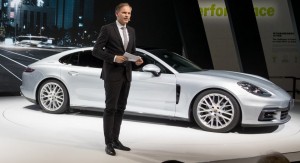Daily Archives: April 23, 2017
Porsche Panamera Executive Unveiled at Shanghai Auto Show 2017
Porsche just unveiled a long wheelbase version of its Panamera at the 2017 Shanghai Auto Show. The German automaker calls it the Porsche Panamera Executive.
China-Exclusive Model
First, it should be noted that the Panamera Executive will only be available in the Chinese market. Recognizing the potentials of the luxury vehicle segment in China and the preference of its rich personalities to be chauffeured to their destinations as they ride comfortably in the rear passenger seats, the automaker decided to offer the long wheelbase car in the giant Asian country.
Strong Demand for Luxury Cars in China
According to TheDrive, China was the strongest single market for the Porsche brand in 2015 to 2016. In a year on year basis, the sales of the brand rose up to 12 percent. The vehicles delivered by the brand to customers numbered up to 65,246. So far, the automaker seems to be carrying over its momentum this year.
From a market data, it was recorded that luxury SUVs and sedans have huge following from wealthy Chinese consumers. The sports car line does not enjoy the same level of demand but Porsche remained popular, especially for younger buyers. Among the company’s best-sellers were the Macan, Panamera and 911 units.
The Panamera Executive was showcased by Porsche during the event together with the 911 GTS and 911 GT3 models, which are the two more popular products of Porsche in China last year. The said cars saw an 11% spike in sales from 2015 to 2016.
5 Models to Choose From
Porsche revealed all five new long wheelbase models in Shanghai. These include the Panamera 4 Executive, Panamera 4S Executive, Panamera Turbo Executive, Panamera 4S E-Hybrid Executive, and Panamera Turbo S E-Hybrid Executive.
Drivetrain
The Panamera Executive has a rear-wheel drive system. The lineup is highlighted by the Porsche Panamera Turbo S E-Hybrid. The car is powered by a 3.0-liter turbo V6 engine. The unit is capable of producing a 330 hp output.
The Volkswagen ID Crozz Vs. Skoda Vision E
Many automakers showcased their concept cars at the 2017 Shanghai Auto Show. Most of them offer a hybrid or all-electric powertrain. Among them were the Volkswagen ID Crozz and the Skoda Vision E concept cars.
Looking at the two vehicles, they surely bear a striking resemblance with each other. After all, their brands are closely related. Here is a quick look at their key features:
Exterior
Skoda is a Czech brand but it is a wholly-owned subsidiary of the Volkswagen Group since 2000. Therefore, it is no longer surprising that the Skoda Vision E shares the same platform with the Volkswagen ID Crozz concept.
Side-by-side, the two concept SUVs have the same form, dimensions and panoramic roofing. They also got rid of the traditional front grille. The noticeable differences in their exterior lies in the lighting system, bumpers, body lines, wheels and badges only.
Interior
Skoda had taken liberties in the interior of the Concept E compared to the ID Crozz of Volkswagen. While the ID Crozz offers what looks like a futuristic but minimalist approach, the Concept E is adorned with a lot of gizmos, including three displays in the dashboard and more controls. The Concept E appears to have more prominent wood trims and leather accents too.
Power Unit
The new Volkswagen and Skoda concept vehicles share the same powertrain. Each auto is powered by two electric motors located at the front and rear.
The front motors of the ID Crozz and Concept E each provides an output of 75 kW. The rear electric motor produces 150 kW. Overall, each vehicle has a total output of 225 kW.
The concept cars are powered by a 83 kWh battery with regenerative braking technology. The tech is a form of energy recovery mechanism, which adds to the energy efficiency of the vehicles. Based on Skoda, the EVs can cover a distance of 500 km at full charge.
Lilum Jet: Meet the New Flying Car of the Future
A flying car used to be a subject of a science fiction novel. With the rapid development of technology, it is slowly becoming a reality. Recently, another flying car was previewed in Germany called the “Lilium Jet”.
How it was considered to be a car beats us, because it is more like a small jet. The Pop.Up of Airbus is more of a car than this one. However, if we take a look back at the flying cars in movies, Lilium resembles a lot of them.
Key Features
According to the Verge, Lilium Jet is being developed by Lilium Aviation. The company is a startup based in Munich, Germany.
The flying car is electric-powered with two-seating capacity. It features a vertical take-off and landing (VTOL) operation, thanks to its 36 propellers distributed across its 10-meter wings and 12 movable flaps. Then once airborne, the flaps adjust horizontally to provide the small aircraft a forward thrust.
Lilium said that the electric battery of the jet has 90% better efficiency than the drone-styled aircraft. The prototype is capable of covering a range of 300 kilometers at full charge and it is 300 km/h quick. That will definitely get you to faraway places fast because it is not hindered by most land barriers such as hills and rough terrains, which serve as challenges to the cars of today.
The Lilium Jet is already undergoing testing. It is still being piloted remotely though. The flying car’s maker claimed that the manned testing of the aircraft is near.
Challenges
While the technology to build flying cars is close-at-hand, there are a lot of hurdles it must face before it reaches mass production for consumers. As pointed out by Mathias Thomsen of Airbus, there is the issue in public infrastructure. But this can be resolved with careful urban planning. Next are the modern day road regulations.








